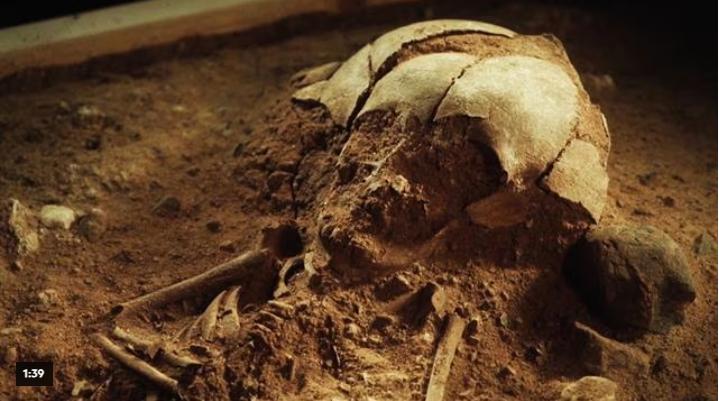Introduction
Archaeology has the power to transport us back in time, unveiling the mysteries of long-lost civilizations and shedding light on the lives and practices of our ancient ancestors. In 2009, a remarkable discovery along the Motala Ström River in southern Sweden did just that, offering a glimpse into the intriguing rituals of Mesolithic hunter-gatherers who lived nearly 8,000 years ago.
As construction crews prepared to build a new railway bridge, archaeologists stumbled upon a treasure trove of artifacts that would captivate the world. Animal bones, tools crafted from antlers, wooden stakes, and even human skull fragments were unearthed from the bog’s lime sediment, hinting at a remarkable and previously unknown burial practice.
Over the next several years, a team led by Fredrik Hallgren of the Cultural Heritage Foundation would uncover the first known instance of Mesolithic hunter-gatherers mounting human skulls on wooden stakes. This extraordinary discovery, detailed in a study published in the journal Antiquity, has sparked new questions and opened a window into the beliefs and rituals of these ancient societies.

Uncovering the Kanaljorden Excavation Site
The Kanaljorden excavation site, located near the Motala Ström River, proved to be a veritable time capsule, revealing a wealth of information about the Mesolithic hunter-gatherers who once inhabited the region. When the team began their excavations in 2011, they were initially hopeful of finding animal bones, but what they uncovered was far more remarkable.
Amidst the densely packed layer of large stones, the archaeologists unearthed the skulls of nine adults and one infant, all deliberately placed and displaying clear signs of trauma. Two of the skulls had well-preserved wooden stakes dislodged inside them, suggesting they had been mounted prior to being deposited in the lake.
The arrangement of the skulls and the accompanying animal bones was equally intriguing. The researchers noted that the bones had been sorted according to the type of creature they belonged to, indicating a deliberate and thoughtful placement. “They somehow seem to differentiate between humans and animals but also animals in different categories,” Hallgren observed.
Examining the Skull Remains
The discovery of the Kanaljorden skulls has provided a wealth of information about the individuals who once inhabited this ancient site. DNA analysis revealed that two of the male skulls were likely related, perhaps cousins or more distant relatives.
The skulls themselves showed clear signs of trauma, with blunt force injuries near the tops of the heads and other wounds that had partially healed. The female skulls exhibited injuries on the back and right sides, while the male skulls each had a single blow to the top of the head and face.
Hallgren noted that these were not individuals who had recently been killed and then placed on display. “More than half of them had this healed trauma to the head,” he explained, suggesting a more complex and potentially ritualistic history.
Theories and Interpretations
The Kanaljorden discovery has left archaeologists and historians grappling with a number of intriguing questions. What was the purpose of mounting the human skulls on wooden stakes? Was this a practice unique to this particular community, or did it reflect a broader cultural tradition among Mesolithic hunter-gatherers?
One possibility is that the display of the skulls was a deliberate funeral act, meant to honor members of the local community. Hallgren, however, believes it is unlikely that the skulls were trophies, as the practice of decapitating enemies was not typically associated with Mesolithic societies.
Another theory is that the blunt force trauma and subsequent display of the skulls could have been related to gender-based violence, spousal abuse, or even raiding and warfare. The varying patterns of injury on the male and female skulls lend some support to this idea.
Ultimately, the researchers acknowledge that there are no direct parallels to this type of burial practice in the archaeological record, making it challenging to draw definitive conclusions. “We are also working on situating this site in the local and the regional archaeological context,” Hallgren noted, emphasizing the need for further research and excavation in the surrounding area.
Implications and Significance
The Kanaljorden discovery has profound implications for our understanding of Mesolithic hunter-gatherer societies. These ancient communities, long thought to have respected the bodily integrity of their dead, have now been shown to engage in a previously unknown ritual practice that challenges our preconceptions.
The deliberate placement and display of the human skulls on wooden stakes suggests a level of complexity and symbolic meaning that goes beyond the simple burial of the dead. It raises questions about the beliefs, social structures, and power dynamics that may have existed within these communities.
Moreover, the Kanaljorden site represents a rare and invaluable window into the lives and practices of Mesolithic hunter-gatherers. As Sara Gummesson, a co-author of the study, noted, “There are many aspects that could be discussed regarding these finds, and I do believe we must keep an open mind about any new results that will come out of the continued work.”
Conclusion
The discovery of the Kanaljorden skull ritual has captivated the archaeological community and the public alike, offering a tantalizing glimpse into the lives and beliefs of our ancient ancestors. While the full meaning and significance of this practice may never be fully understood, it serves as a powerful reminder of the richness and diversity of human culture throughout history.
As researchers continue to excavate and analyze the Kanaljorden site and its surrounding areas, we can expect new insights to emerge, further expanding our understanding of the Mesolithic hunter-gatherers and the complex, often surprising ways in which they engaged with the world around them. This remarkable discovery is a testament to the enduring power of archaeology to uncover the hidden stories of the past and inspire us to explore the depths of human experience.


